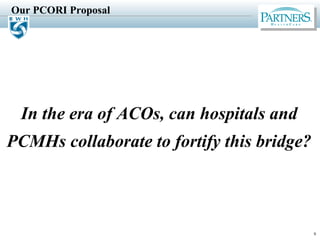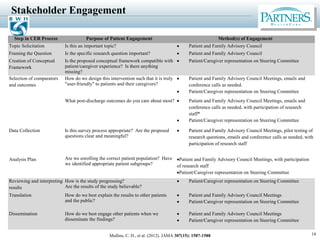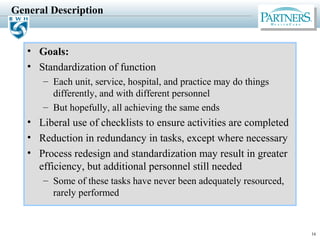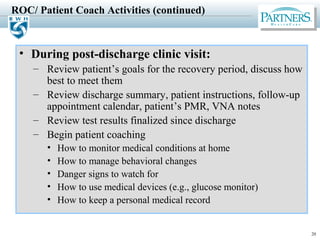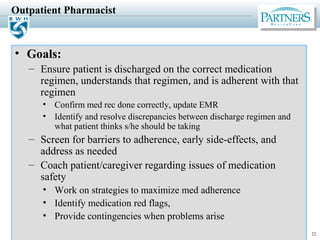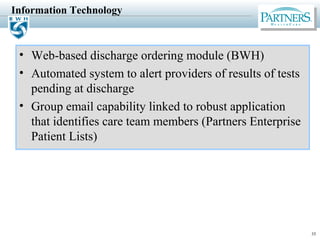Weitzman 2013 Relative patient benefits of a hospital-PCMH collaboration within an ACO to improve care transitions.
- 1. 1 Relative patient benefits of a hospital- PCMH collaboration within an ACO to improve care transitions Anuj K. Dalal, MD, FHMAnuj K. Dalal, MD, FHM BWH Hospitalist ServiceBWH Hospitalist Service Associate Physician, Division of General Medicine,Associate Physician, Division of General Medicine, Brigham and WomenBrigham and Women’s Hospital’s Hospital Instructor, Harvard Medical SchoolInstructor, Harvard Medical School Co-InvestigatorCo-Investigator
- 3. About the Principal Investigator 3 Dr. Jeffrey L Schnipper
- 4. 4 Goals of this Talk • To describe the design of the newly funded PCORI study: – “Relative patient benefits of a hospital-PCMH collaboration within an ACO to improve care transitions” • To review the several components of the intervention • To discuss early experience and potential implications for communities
- 5. Description of study design 5
- 6. 6 Specific Aims • Aim 1: To develop, implement, and refine a multi-faceted, multi-disciplinary transitions intervention with contributions from hospital and primary care personnel across several PCMHs within the Partners Healthcare Pioneer ACO. • Aim 2: To evaluate the effects of this intervention on post- discharge adverse events, functional status, patient satisfaction, and emergency department and hospital utilization within 30 days of discharge. • Aim 3: To understand barriers to and facilitators of successful implementation of this intervention across practices
- 7. 7 Rationale • Partners is increasingly focused on improving value for patients and is now a “Pioneer Accountable Care Organization (ACO)” – Partners hospitals have several financial incentives to reduce 30-day readmissions – As part of the ACO effort, most primary care practices will soon become Patient-Centered Medical Homes (PCMH) – In theory, both Partners hospitals and primary care practices will have a vested interest in preventing readmissions • An ideal transition requires efforts of inpatient and outpatient personnel – BUT, there are limits to how much can be provided by the hospitals alone without participation and complete buy-in of primary care practices
- 8. 8 Conceptual Model: Ideal Transition in Care Burke, Kripilani, Vasilevskis, and Schnipper. JHM 2013.
- 9. Our PCORI Proposal 9 In the era of ACOs, can hospitals and PCMHs collaborate to fortify this bridge?
- 10. 10 Intervention Burke, Kripilani, Vasilevskis, and Schnipper. JHM 2013. Dischargeplanofcare Inptandouptpharmacistmedrec Web-baseddischargemodule AutomatednotificationofTPADsFocusededucationandteachback Engagecaregiversandcommunityservices Automatedtriggerofpalliativecareconsult EMR,careteam identification,videoconf VNA assessment;disease-specificmonitor Timelypost-dischargef/u
- 11. 11 Intervention: Main Components • Hospital – Inpatient medication safety interventions* – Inpatient “discharge advocate” (DA) • Primary Care Practices (PCMHs) – Nurse “Responsible Outpatient Clinician” (ROC)/Patient Coach* – Multi-disciplinary post-discharge clinic visit: ROC* /pharmacist* /PCP • Both Hospital and PCMH – Interventions for high-risk patients (e.g., telemedicine)† – Advance care planning‡ – Information technology (e.g., video-conferencing, pending tests)‡ • Other – Visiting nurse intervention † Available, but requires a better payment mechanism ‡ Being worked on as part of an existing project * Require additional personnel, currently under-resourced
- 12. 12 Methods • Patients – 1800 patients admitted to BWH or MGH – Affiliated with 50 Partners’ primary care practices “primed” to become PCMHs • Study Design: “Stepped Wedge” – Randomize order in which each practice implements the intervention (once achieve “primed” status) • Outcomes Assessment: 30 days post-discharge by phone interview and medical record review: – Adverse events – Patient satisfaction and functional status – Health care utilization (e.g., ED visits, readmissions, etc.) – Preventability of readmission via 360-degree review (patient/family, inpatient attendings, PCP)
- 13. 13 Methods • Mixed Methods – Evaluate facilitators of and barriers to implementation via provider surveys and focus groups – Iteratively refine intervention components • Subgroup Analyses – Who benefits the most? (e.g., elderly, low health literacy, etc.) • Engage Patient and Caregiver Stakeholders – Patient and family advisory council – Patient/family representation on study steering committee
- 14. Stakeholder Engagement 14 Step in CER Process Purpose of Patient Engagement Method(s) of Engagement Topic Solicitation Is this an important topic? • Patient and Family Advisory Council Framing the Question Is the specific research question important? • Patient and Family Advisory Council Creation of Conceptual Framework Is the proposed conceptual framework compatible with patient/caregiver experience? Is there anything missing? • Patient/Caregiver representation on Steering Committee Selection of comparators and outcomes How do we design this intervention such that it is truly "user-friendly" to patients and their caregivers? • Patient and Family Advisory Council Meetings, emails and conference calls as needed. • Patient/Caregiver representation on Steering Committee What post-discharge outcomes do you care about most? • Patient and Family Advisory Council Meetings, emails and conference calls as needed, with participation of research staff* • Patient/Caregiver representation on Steering Committee Data Collection Is this survey process appropriate? Are the proposed questions clear and meaningful? • Patient and Family Advisory Council Meetings, pilot testing of research questions, emails and conference calls as needed, with participation of research staff Analysis Plan Are we enrolling the correct patient population? Have we identified appropriate patient subgroups? •Patient and Family Advisory Council Meetings, with participation of research staff •Patient/Caregiver representation on Steering Committee Reviewing and interpreting results How is the study progressing? Are the results of the study believable? • Patient/Caregiver representation on Steering Committee Translation How do we best explain the results to other patients and the public? • Patient and Family Advisory Council Meetings • Patient/Caregiver representation on Steering Committee Dissemination How do we best engage other patients when we disseminate the findings? • Patient and Family Advisory Council Meetings • Patient/Caregiver representation on Steering Committee Mullins, C. D., et al. (2012). JAMA 307(15): 1587-1588
- 15. A detailed description of selected intervention components 15
- 16. 16 General Description • Goals: • Standardization of function – Each unit, service, hospital, and practice may do things differently, and with different personnel – But hopefully, all achieving the same ends • Liberal use of checklists to ensure activities are completed • Reduction in redundancy in tasks, except where necessary • Process redesign and standardization may result in greater efficiency, but additional personnel still needed – Some of these tasks have never been adequately resourced, rarely performed
- 17. 17 Inpatient Discharge Advocate • Goals: – Point person for patient, family, post-discharge providers – Coordinate discharge plan with the patient, caregivers, hospital team, and outpatient team • Communicate and manage expectations with patient/family re: discharge plan, follow-up appointments • Coordinate communication among clinicians for timely decision-making and handoffs in care (e.g., fax discharge documents, facilitate care team emails) – Educate and prepare patient and caregivers for discharge • Resolve barriers to executing post-discharge plan (e.g., filling prescriptions, transportation) • Perform safety checklist (e.g., adequate monitoring, discharge documentation, follow-up)
- 18. 18 Responsible Outpatient Clinician (ROC)/Patient Coach • Goals: – Serve as a bridge between inpatient stay and outpatient clinic – Modify post-discharge plan as needed – Coach patients and caregivers so that they are best able to carry out the post-discharge plan
- 19. 19 ROC/ Patient Coach Activities • While patient is still in the hospital: – Ask patient about most important goals for recovery period – Discuss reasons for and importance of keeping follow-up appointments – Remind patient to bring discharge instructions, personal medical record, follow-up calendar, medication list, pill bottles – Review use of personal medical record – Discuss barriers to keeping post-discharge appointments and explore ways to overcome them – Use teach-back to confirm understanding
- 20. 20 ROC/ Patient Coach Activities (continued) • During post-discharge clinic visit: – Review patient’s goals for the recovery period, discuss how best to meet them – Review discharge summary, patient instructions, follow-up appointment calendar, patient’s PMR, VNA notes – Review test results finalized since discharge – Begin patient coaching • How to monitor medical conditions at home • How to manage behavioral changes • Danger signs to watch for • How to use medical devices (e.g., glucose monitor) • How to keep a personal medical record
- 21. 21 ROC/ Patient Coach Activities (continued) • Make 3 phone calls during the month after discharge – Perform coaching activities as above • For high-risk patients, conduct home visits – Evaluate patient/caregiver’s ability to carry out plan at home – Perform coaching activities as above • For all activities – Use role-playing and teach-back as needed – Contact inpatient providers as needed – Identify barriers to self-management and explore ways to overcome barriers with patient, caregiver, and PCP – Communicate with PCP, makes plans/arrange follow-up as needed – Document findings in the EMR
- 22. 22 Outpatient Pharmacist • Goals: – Ensure patient is discharged on the correct medication regimen, understands that regimen, and is adherent with that regimen • Confirm med rec done correctly, update EMR • Identify and resolve discrepancies between discharge regimen and what patient thinks s/he should be taking – Screen for barriers to adherence, early side-effects, and address as needed – Coach patient/caregiver regarding issues of medication safety • Work on strategies to maximize med adherence • Identify medication red flags, • Provide contingencies when problems arise
- 23. Potential implications – what will we learn? 23
- 24. 24 Early Experience with Study • ACO leadership is supportive – Believe it is the right thing to do – Believe it will require additional resources – Willing to work together across traditional silos – Are they willing to open their pockets? • Everyone feels financially constrained • ROI is a leap of faith • Incentives are still not completely aligned
- 25. 25 Early Experience with Study • Patient and caregiver engagement – Changes dynamic of steering committee meetings – What components of the intervention do they really care about? – How does it feel to receive this intervention? – What outcomes do they care about? – Does an adverse event mean to same thing to patients as they do to clinicians?
- 26. Discussion • Implications for communities – Should communities be embracing the move towards consolidation, ACOs, PCMHs? – What are the cons? • Might mean less choice of providers, might feel more “corporate”, might mean less time with MDs and more time with other providers, etc. – What are the pros? • Might mean better coordination of care, better access to data, different ways to provide care outside a visit, more proactive care – Does the answer depend on who you are? 26
- 27. Thank You! • Questions? Comments? • Special thanks to our PCORI team: – Nyryan Nolido, MA – Gwen Crevensten, MD – Eric Weil, MD – Cherlie Magny-Normilus, NP – Asaf Bitton, MD, MPH – Maureen Fagan, DNP, MHA – David Bates, MD, MSc – Lipika Samal, MD, MPH – Stephanie Labonville, Pharm D – Joe Frolkis, MD – Namita Mohta, MD – Jackie Somerville, RN, PhD 27
- 28. Additional Info • The remaining slides provide additional information about the intervention components and study design 28
- 29. 29 Inpatient Medication Safety Intervention • Goals: – Ensure accurate medication reconciliation • In-depth med rec at admission and discharge • Communication with post-discharge providers re: discharge medication regimen, reasons for changes, etc. – Educate patients/caregivers about the discharge medication regimen • Help understand discharge regimen (indications, special instructions, how and why different from before) – Prepare patients/caregivers to take medications safely and correctly after discharge • Minimize adverse drug events
- 30. 30 Other Inpatient Care Providers • Goal: Standardize and distribute work • Primary nurse: – Talk with ROC, learn about patient, communicate – Document discharge patient instructions • Behavioral changes, final discharge plan, red flags, discharge status – Educate patient and family • Identify active learner, review instructions, use teach-back – Give patient personal medical record to use • Unit coordinator: – Schedule follow-up appointments based on time-frame, patient/caregiver and provider availability – Give patient calendar of follow-up appointments
- 31. 31 Partners Healthcare at Home (PHH) • Goals: – Assess patient’s home situation, current services, and level of support – Ensure ability of patients/caregivers to manage their medical conditions at home • Take medications, perform wound care, modify health- related behaviors (e.g., diet), manage follow-up appointments • Assist /teach patients/caregivers to perform these activities until independent or no longer needed – Communicate with members of the transition care team • Document findings in EMR, communicate with inpatient and outpatient care team by group email re: discharge plan
- 32. 32 Other Outpatient Providers: PCP • Goals: – Evaluate status of active medical problems compared with discharge and post-discharge visits based on discharge summary and VNA notes – Discuss advance directives as needed – Follow up on any other issues raised by discharging team, visiting nurse, ROC, outpatient pharmacist, and communicate with these providers as needed (i.e., outpatient specialists) – Arrange for additional follow-up as needed (e.g., closer monitoring of chronic conditions, social worker or psychiatric follow-up, palliative care services)
- 33. 33 Interventions for High-Risk Patients • Home visits by patient coach • Telemedicine programs: – CHF: weights – Diabetes: POC glucose testing – Hypertension: blood pressures
- 34. 34 Advance Care Planning • Automatic trigger tool for inpatient palliative care consultation • Structured consultation regarding goals of care discussion with patients, caregivers, and providers • Communication with outpatient providers so discussion can be continued • Documentation in the EMR
- 35. 35 Information Technology • Web-based discharge ordering module (BWH) • Automated system to alert providers of results of tests pending at discharge • Group email capability linked to robust application that identifies care team members (Partners Enterprise Patient Lists)
- 36. Analysis • Quantitative – Primary Outcome: Adverse events within 30 days of discharge • Logistic regression adjusted for study month, arm, and confounders • Clustered by nursing unit, practice, attending, and PCP – Secondary Outcomes: • Preventable adverse events • Duration of ameliorable adverse events • Patient satisfaction • ED and hospital readmission • Change in functional status – Subgroup analyses: elderly, low health literacy, high co-morbidity, high risk for readmission 36
- 37. Analysis • Qualitative – Grounded theory method • Analyze focus groups and interviews re: barriers and facilitators of implementation – Mixed methods • Are certain facets consistently implemented with high fidelity and associated with improved outcomes? • Where success is variable, can it be linked to choice of implementation components, low intervention fidelity? • Can low intervention fidelity be linked to certain contextual factors? 37
Editor's Notes
- Think of the 10 domains of an ideal transition as structural supports of the ‘‘bridge’’ patients must cross from one care environment to another during a care transition. Those domains that mainly take place prior to discharge are closer to the ‘‘hospital side’’ of the bridge, those that mainly take place after discharge are closer to the ‘‘community side’’ of the bridge, while those that take place both prior to and after discharge are in the middle. Lack of a domain makes the bridge weaker and more prone to gaps in care and poor outcomes. The more that is missing, the less safe the bridge is. In the worst case, the patient then falls off the bridge and must make it back either to the community or more realistically, the hospital -> readmissions.
- Some intervention components are adequately resourced, just need standardization: VNA visit Inpatient DA Some components are in place but need a better payment mechanism: Telemedicine programs through Center for Connected Health Some components are being worked on through existing projects: Palliative Care IT: TPADs, video conferencing, mobile technologies Some components are frankly under-resourced, and we ’re using the grant as a way to get these resources: Inpatient pharmacists to do medication safety interventions Nurse ROC/Patient Coach Outpatient pharmacists
- Communicate with patient/family re: discharge planning Confirm patient can get to follow-up appointments Give patient/family realistic expectations of date/time of discharge Coordinate communication among clinicians for timely decision-making and handoffs in care Fax discharge documents to relevant out of network specialists Inform inpatient pharmacists regarding patient ’ s needs, estimated discharge date Enter all providers into Partners Enterprise Patient List application, initiate group emails Identify, communicate, and make plans to resolve barriers to patients/caregivers being able to carry out the post-discharge plan Perform safety checklist Adequate post-discharge monitoring is in place Resident ’s discharge documentation is adequate Timing of follow-up is adequate Point person in case patient, family, or post-discharge providers have questions about the hospitalization
- While patient is still in the hospital Ask patient about most important goals for recovery period Discuss reasons for and importance of keeping follow-up appointments Remind patient to bring discharge instructions, personal medical record, follow-up calendar, medication list, pill bottles Review use of personal medical record Discuss barriers to keeping post-discharge appointments and explore ways to overcome them Use teach-back to confirm understanding During post-discharge clinic visit Review patient ’s goals for the recovery period, discuss how best to meet them Review discharge summary, patient instructions, follow-up appointment calendar, patient ’s PMR, VNA notes Review test results finalized since discharge Begin patient coaching How to monitor medical conditions at home How to manage behavioral changes Danger signs to watch for How to use medical system How to keep a personal medical record
- Confirm medication reconciliation done correctly in the hospital and at discharge, update EMR Identify and resolve discrepancies between discharge regimen and what patient thinks s/he should be taking Answer questions about medications Ensure patient has filled prescriptions and knows how to obtain refills Assess adherence with medications, address as needed Identify and manage possible medication side-effects Contact inpatient team as needed Communicate with PCP, make changes to medications as needed Provide patient coaching Work with patient/caregiver on strategies to maximize medication adherence, how to identify medication red flags, what to do if problems arise Document findings in the EMR
- How does it feel? To be called “high risk” Too overwhelming Shameful Invasive (privacy) Or Empowering Like someone cares Easy to navigate User friendly
- Activities tailored to patient ’s needs In-depth medication reconciliation at admission and discharge Patient/caregiver education re: medication changes, reasons for changes, potential side effects, etc. Communication with post-discharge providers by email re: discharge medication regimen, reasons for changes, establishing a point of contact
- Evaluate ability of patient to function at home with current level of support and services Evaluate and address ability of patient/caregiver to perform necessary self-care activities Take medications Perform other treatments (e.g., wound care) Modify health-related behaviors (e.g., diet) Manage follow-up appointments Assist with above activities as needed Teach patients/caregivers to perform these activities until they are independent or the activities are no longer needed Document all findings in templated note in EMR Communicate with inpatient attendings by email (and cc PCP and NP) re: questions with discharge plan, status at time of discharge, etc. Communicate with outpatient providers (PCP, NP, specialists) regarding plan of care








